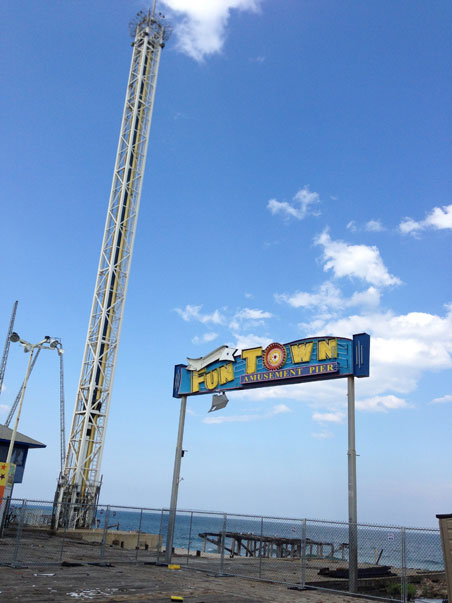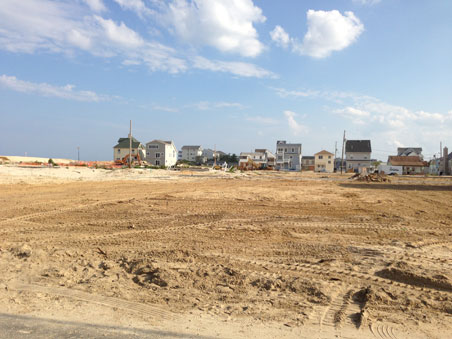New Yorker Calls for Retreat From the Jersey Shore Barrier Islands. Easy for the New Yorker to say.
On Monday, I drove to Seaside Park to visit a friend who’s staying there this summer. For the last six years, I’ve spent a lot of time writing about the Southern Jersey Shore, which I consider Atlantic City to Cape May. This was my first time seeing this part of our coast not via pictures of post-Sandy damage.
Seaside isn’t one town. It’s a cluster of towns that share part of the same name, just like we have Wildwood, North Wildwood and Wildwood Crest instead of one Wildwood at the South Jersey Shore.
Seaside Heights holds the main chunk of the boardwalk here. It’s a lot like Wildwood’s boardwalk except with more visible bars and less creative T-shirts. I did a lot of touristy things on my boardwalk stroll: took a picture of the closed FunTown Pier and saw what was left of the Casino Pier that had just re-opened on Friday, even though the back chunk of it still looks much like it did in November (one amusement booth beyond the heavy fencing still had T-shirts hanging on the wall, though the Jet Star — the roller coaster that fell into the ocean — has since been demolished). I had a slice of pizza from Maruca’s, which makes the same Trenton-style pizza I love from Manco & Manco’s, though they don’t do birch beer up here. If you could look past the springy new boardwalk boards and the destruction that hung off the amusement piers, it seemed very Jersey Shore normal.
The casino pier in Seaside Heights, former home of the Jet Star. | Photos by Jen A. Miller
Of all the Seasides, Seaside Heights was most damaged by Sandy. There wasn’t anything to stop the water rushing through the boardwalk and into town, which is why the Jet Star fell into the ocean. They didn’t have the dunes that the more residential Seaside Park and South Seaside Park have. Those dunes are still, even post-Sandy, as high as 25 feet.
Fun Town pier in Seaside Park.
The difference is striking. Where shore life continues at a leisurely, late-summer pace, some homes in Seaside Park are still boarded up or empty. Just north is Ortley Beach where there are parking lots of sand where homes used to be. They just weren’t worth saving, or floated away.
The former site of homes in Ortley Beach.
But even in the rest of the Seasides, the storm him differently block by block. Midway Beach, a beach-front community of one-story homes within South Seaside Park, only had one home with any water damage. Across the street, in another small community, homes are empty because of mold.
Yet life here goes on. The boardwalk music plays. Kids in bathing suits ride bikes while holding surfboards, and the nine-to-fivers come onto the beach after work to surf the evening waves, or just sit with their feet in the sand on a nice summer day.
A recent New Yorker article called for retreat from the Jersey Shore barrier islands. That’s an easy thing for the New Yorker to say after dropping into a town to report a story. When you aren’t from here, nor have generations of history in one place stacked behind you, sure, it’s a snap to point at a bunch of people who you don’t know, tell them their deep roots in a place are non-factors, and tell them they must go. Climate change is a very real and scary thing, but for every town of flattened homes and roller coasters in the ocean, there’s a South Seaside Park that saw only a skim of damage because of the dune system that held strong against 90 mile per hour ocean winds slamming into it during a hurricane.
Despite the scar that this region will carry for a lifetime (in every conversation I had with people about Sandy, the Storm of ’62 came up as well; those wounds run deep), there won’t be a blanket retreat. There were far too many people on that boardwalk and those beaches on a mild Monday afternoon to make a valid case for that. “I’ll chain myself to a dune fence,” a friend said if he was told to leave.
I’d join him.





